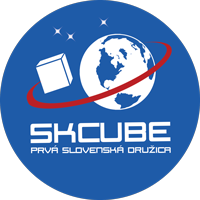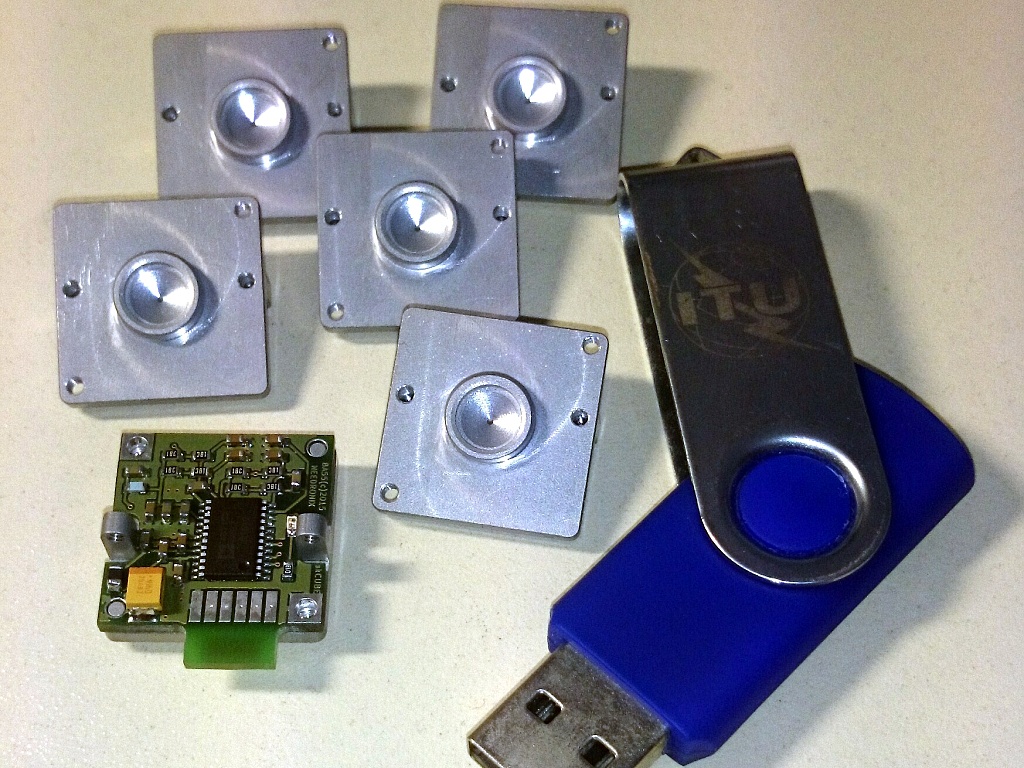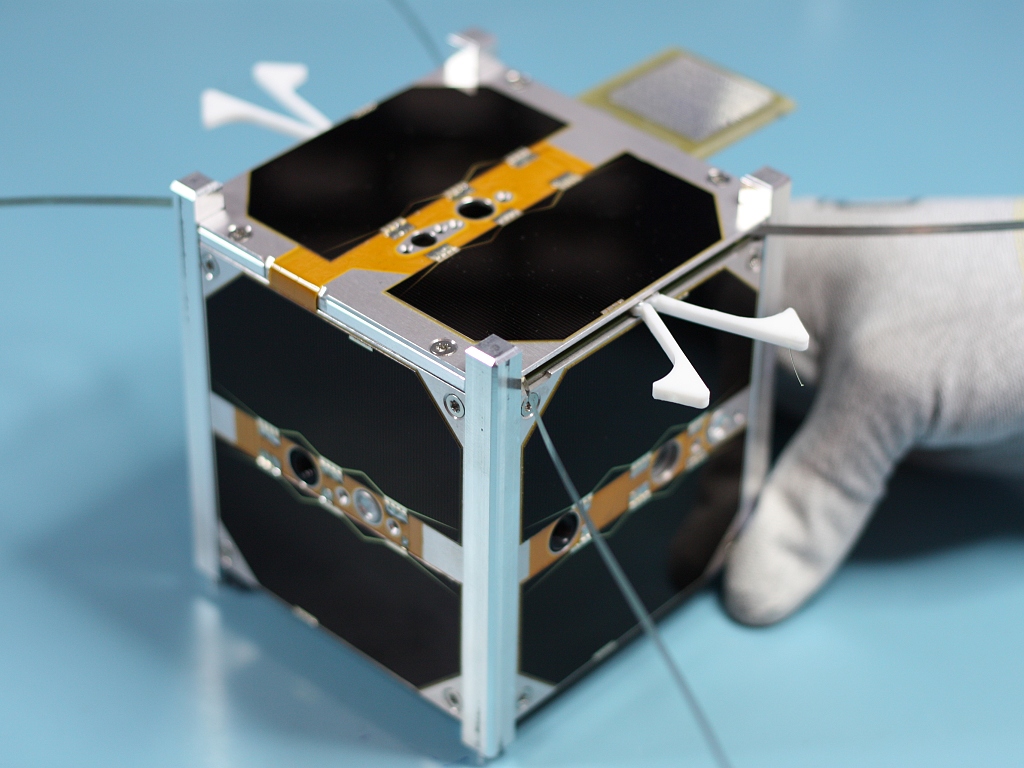Summary
Space technologies give our society unprecedented opportunities and benefits. One of them is the potential to be able to harness the curiosity and skills of engineers and scientists, resulting in unique projects like the one called skCUBE.
This project is about the creation of the first Slovak satellite, which was completely developed and constructed in Slovakia. Our aim was primarily to gain hands-on experience with everything involved in satellite manufacturing and to strengthen Slovakia’s position within the European Space Agency’s (ESA’s) group of cooperating states.
skCUBE was built essentially from scratch. We designed and constructed almost all of it, including the circuit boards, sensors, parts of the testing equipment, software and calibration methods.
The main on-board experiment is a very-low-frequency receiver consisting of an antenna commonly known as the magnetic loop. It will allow us to observe radio signals in space at frequencies from 3 to 30 kHz blocked on Earth by the ionosphere.
Keywords: satellite; cubesat; space
INTRODUCTION
The first Slovak satellite skCUBE is ready to take its journey into outer space. It is a good time now to look back at the successes and obstacles, which we had to pass during this project. The story of the satellite began already in 2009, but officially we started to work on it in 2011. After several successful missions of our stratospheric probe flights codenamed JULO [1,2,3,4,5,6,7,8], we acquired a desire to go higher and conquer the boundary of outer space. The satellite skCUBE started to be our big dream. We faced the following question many times: ‘Does it make sense to work on this project? We have enough space debris in orbit already and the “bread won’t get cheaper”’.
Yes, we could talk about this for a long time, but let us list here several major aspects, which proved to us the potential of such this project: i) knowledge – during the construction of the satellite we did it our own way. We designed and built printed circuit boards, drew a 3D satellite model, programmed software, developed sensors, measuring methods, testing tools and calibration methods. The satellite know-how is now ours. This ‘painful’ way taught us a lot, because we had to overcome a lot of specific problems; ii) public outreach – Slovakia is now an ESA cooperating state and skCUBE confirms that we belong in this exclusive community after all. We want to convince young people to go and study technical fields because it pays off; iii) science – our satellite will contribute significantly to science as well. We developed a radio waves detector, which will listen to radio waves at very low frequencies (3-30 kHz) generated by terrestrial lightning and potentially also Earth’s magnetosphere.
The space sector has become a part of every day life for people in many countries in the world. It is present in many space spin-off technologies, such as: GPS, weather satellites and satellite TV. The power of most of the biggest economies in the world is tied to the business with knowledge. Therefore, investments in education and science are the only way to bring Slovakia to this ‘elite club’. The space program in Slovakia has to start somehow. We think that cubesats are an appropriate way to get us there. It is not just student debris in space, but also an ideal way of gaining the know-how and experience in making relatively cheap experiments in space.
SATELLITE
In the following sections we will introduce the satellite from a technical perspective and describe our main innovations.
On-board computer
The on-board computer (OBC) is the brain of the whole satellite. It communicates with other peripherals, stores information to the internal memory and divides tasks. It is designed in a redundant way, so in the case of failure, control is taken over by a backup system.
The heart of the OBC is a processor MSP430 with static architecture and a connectable FRAM to improve its radiation resistance. Failure is equally detected by a radiation resistant watchdog, a component that monitors the work of the active microcomputer. The OBC also has a unique real-time operating system developed by us [9] for over more than 3 years.
Communication module (COM)
The communication module (COM) is also redundant. Its primary channel works at a frequency of 437.1 MHz and is used to transmit telemetric data using an AX.25 protocol. We also developed the experimental transmission of images with a frequency of 2401 MHz at a speed up to 240 kbps. With colleagues from ilina University, we have worked on progressive encoding methods using LDPC channel codes, which will secure a reliable reception even at low signal to noise ratios.Communication inherently involves antennas. Here we had to figure out the antenna deployment and their release from their containers.
The system works now in such a way, that antennas are rolled inside the satellite like a measuring tape blocked by doors held by a thread. This system was developed to be very reliable, so that for instance the antennas would not deploy prematurely in the rocket, and the resistors would burn the holding thread and release the antennas at the right moment. The antennas were crucial for the communication system, which is why a great number of concepts and measurements were tried before we found parametrically the right antenna.
Video 1: Test antenna
An interesting piece of the satellite’s technology is our patch antenna for the 2.4 GHz, where the main problem was the available space for it. Thus, it had to fit within 40x40 cm and only have a height of 1.5 mm. Nevertheless, it has a good gain of 6 dBi and right-handed polarization. We also had to develop a unique deployment system for the patch antenna.
On-board camera (CAM)
The on-board camera (CAM) serves for taking images of the Earth. Our aim is to take a picture of Slovakia from space. An image detector with the resolution of 750x480 pixels and low noise is the basis of the camera. The optics have a field view of 60 degrees and contain an infrared (IR) and neutral density (ND) filter. Image processing is performed by a microcontroller STM32F407, which also does all of the post-processing, including JPEG compression. A picture snapshot from orbit can be scheduled from the ground and stored into an external FLASH memory.
Power supply (PSU)
The power supply (PSU) secures energy for the whole satellite. It gains it from solar panels, stores it in batteries and divides it into individual modules. It can detect the increased consumption of a device and adjust itself accordingly very fast. In case of a low energy situation, it can disconnect systems, which are not vital for satellite’s operation. The design of its printed circuit board will last for about 2 years and it is the most complicated part of the whole satellite. We had to fit approximately 1000 components into a very small space and 6 layers.
Not all of the components could be purchased in high enough quality for deployment in space. Therefore, the rest of the components had to pass radiation tests, so that we could learn what to expect from them and also to approximately determine their life expectancy. Based on these results, we had to modify our original design.
Radiation measurements of satellite’s critical components have been secured by RCM together with the University Centre of Electron Accelerators of the Slovak Medical University.
Attitude determination and control system (ADCS)
The attitude determination and control system (ADCS) is a complex system acquiring the position and orientation of the satellite, based on the information from on-board sensors the: magnetometer, gyroscope, sun-sensor and Earth-sensor.
Both the magnetometer and gyroscope are small SMD devices with a MEMS structure, which are needed to be calibrated before use. We used the system of Helmholtz coils and accurate fluxgate magnetometers for the calibration of our magnetometers.
A unique component of the satellite is the sun-sensor, which can be used to determine the position of the satellite with respect to the Sun. The Sun is a great navigational point in space within our Solar System.
The sun-sensor is made of a duo-lateral PSD detector, which is subject to subsequent processing by an AD convertor. Its theoretical accuracy in its position determination can be up to one tenth of a degree.
Furthermore, the last sensor for position determination is earth-sensor. It is basically a thermo camera with resolution of 16 x 4 pixels, which is capable to determine Earth’s horizon based on temperature contrast.
By optimal fusion of these sensors, we can determine position and orientation of our satellite in space. The satellite will gain initial random rotation after deployment from the rocket, which we need to compensate and stabilize the satellite. For stopping the rotation, we will use B-dot algorithm, which can control active coils based on derivation of magnetic field.
Active coils are electromagnetic coils with a core, which can interact with magnetic field of Earth. In fact, we’ll use magnetic field line as a support point around which we turn the satellite.
A big problem of such coils is hysteresis of the core itself, which causes remnant magnetism and which then interacts with further magnetic measurements. Therefore, we manufactured a core with extremely small hysteresis loop. It took us around a year to find the right material, do computer simulations, measurments, tests and build the core togehter with the wire winding..
Scientific experiment (EXP)
Our scientific experiment (EXP) is a VLF receiver of radio signals in band of 3-30 kHz capable of subsequent signal processing. We would like to use it and primarily detect so called whistlers [11], which will allow us to study terrestrial lightning and Earth’s ionosphere. Our experiment is made from a coil with 1000 turns and cross-sectional area of 42 cm2.
Signal from the coil is amplified using operational amplifier and brought further into internal AD converter of STM32F746 microcontroller, which subsequently processes the signal. Digital filtration of the signal, spectral analysis and event detection based on power flux density is performed on-board as well. The experiment works in 2 modes. The first one is slow capable of detecting spectral changes during the whole orbit. The second mode is fast and allows for fast sampling of quick terrestrial radio events exceeding certain power flux density threshold.
Ground segment (GS)
The ground segment (GS) is inseparable part of a satellite, which will receive, decode and store received data. Primary ground station is being built at amorin. It will be run by ham radio organization SOSA – OM3KAA, where main operator is OM1LD.
This ground segment is a unique project by itself. The concept and precise gears of Slovak manufacturer allows for precise tracking of satellites with accuracy better than 0.1 degree with 100 kg parabolic antenna, which is necessary for keeping connections on frequencies higher than 1 GHz. This ground segment will be possible to use also for next missions and other scientific and ham radio projects. Secondary ground segment will be built soon at the ilina University. For signal reception of our satellite, we’ll also use services of other receiving stations, for example one of the RMC company in Nová Dubnica. Important part of the ground segment is decoding software, which allows for clear display of telemetric data from individual systems and which we developed as well.
HAM radio information
Primary channel:
Modulation: GMSK
Transmitter power: 30 dBm (1W)
Antenna: dipole (2 dBi)
Bit rate: 9600 bauds
Communication protocol: AX.25
Communication protocol: in 30 second intervals
AX.25 digipeater will be allowed in time.
Packet structure and decoding software will appear soon on this website www.druzica.sk Morse code message and simplified telemetry will be sent approximately every 2 minutes.
Secondary channel
Modulation: GMSK
Transmitter power: 24 dBm (250 mW)
Antenna: Patch RHCP (6 dBi)
Communication speed: 40-240 kbps
Protocol: proprietary
-
This high speed channel will be used to send images from on-board camera. Decoding software is currently being developed in Matlab – Simulink and will be available on web after completion.
TLE and SWL Report Form here!
Satellite testing
Development of commercial electronics and electronics for space is totally different.
To get rocket flight permission, we had to pass strict tests, which could reveal even the tiniest problems and flaws in circuit board design or component placements.
The centrifuge itself was tailored and constructed exactly for purpose of this project. We performed next test on a vibrator desk and exposed satellite to vibrations with power density of 18 G and frequency range up to 2000 Hz.
The satellite has survived even this tough test. Last test was satellite’s “vacation” in a vacuum chamber and temperatures around 60 degrees during 24 hours. We tested material evaporation from the satellite.
Maximum allowed value was 1 gram. We didn’t detect any problems here either. These tests were performed at the Institute for experimental physics of Slovak academy of sciences in Košice.
Video 2: Tests
Video 3: Vibration tests
CONCLUSION
At this time, the satellite is fully operational and ready to be launched into space. We have delivered it to the ISL Company in Netherlands in April, who will its secure integration together with others into a so called flight container. Subsequently, they will deliver skCube to a spaceport in California and mount it to SpaceX’s Falcon 9 rocket. Its launch will take place most likely in July.
We will follow the launch, hold our breath and hope that everything will go smoothly. After the release of the rocket’s primary payload, skCube will be one of the next satellites to be released. It will be pushed into outer space by a spring. Antennas will be released after 30 minutes and the satellite will send its first signals to Earth. Finally, we would like to say that the completion of the first Slovak satellite is for us a huge milestone and what will come next is just a cherry on top of the cake.
At this moment, we completed most of our initial goals. We put together a great team [12] and gained a lot experience, which we plan to utilize further. This cubesat has also become one of the reasons why our politicians agreed to sign the cooperation agreement with ESA so Slovakia could become its cooperating state. The satellite has already been generating scientific publications now [9,10]. We believe that we have shown that space research makes sense, that it is an engine for innovations and the knowledge economy, while also being an inspiration and an adventure.






